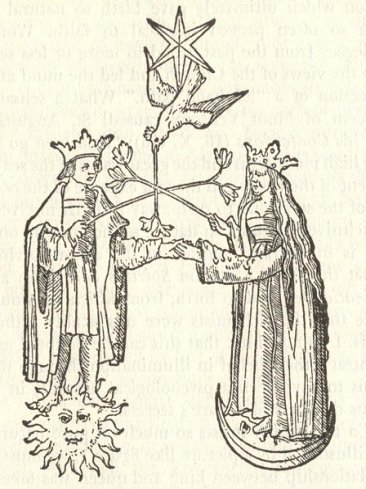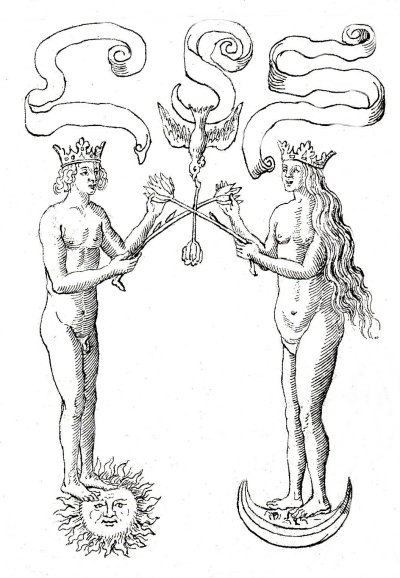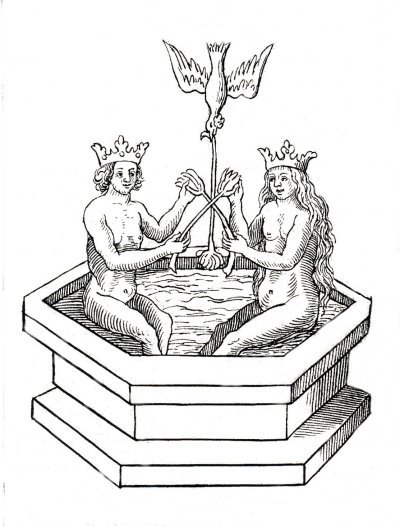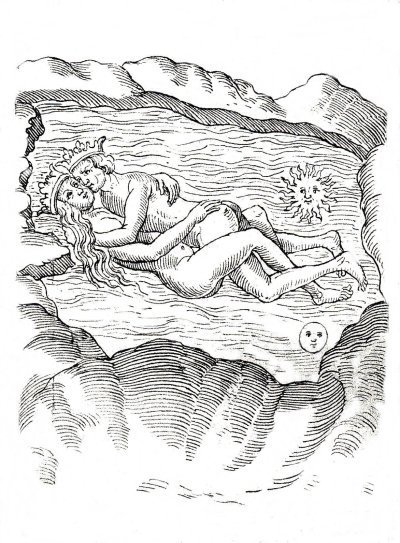From the Bob and Ann Journal Dialogues
Chapter IV
Reuniting the Two as One
Jesus said to them, “When you make the two into one, and when you make the inner like the outer and the outer like the inner, and the upper like the lower, and when you make male and female into a single one . . . then you will enter [the kingdom].”
Gospel of Thomas, Logon 22
Connecting the dots between Emanuel Swedenborg and Carl Jung brought into focus their respective works on the Sacred Union by which the two are reunited so as to become one. For Jung this took form in his Mysterium Coniunctionis, and for Swedenborg in his Amore Conjugiali.
Jung’s Mysterium was the magnum opus of his individuation process, liberally illustrated with 16th alchemical drawings. Edward Edinger expanded on Jung’s text and provided further illustrations in his Mysterium Lectures. The Conjugiali was Swedenborg’s defining expression of his principle of complementary or reciprocating pairs. In essence this principle stated:
Nothing is ever something—i.e., some one thing—but rather two things forming a complementary pair.
In working out his theory of “Conjugial” or Marriage Love, Swedenborg was seeking to understand how the universe worked. His Amore was about “the nuts and bolts of the marriage relationship in a variety of situations.” What would emerge would be his underlying theology of a reciprocal dualism present in all things. Cosmologically, his view of the universe was one in which the two parts of every creative whole were interchangeably giving—the one to the other, and in turn, the other reciprocating by a total re-giving of itself back to the one.
Also central to Swedenborgian thought was his theory of correspondences stating, “on earth as in heaven;” “as above, so below.” When applied to the marriage partnership, he saw the physical and therefore temporal union of two persons as an opportunity by which the interchange of love between the two could so deepen as to unite them in mind and heart as well as physically. According to Swedenborg, such a union was regarded in heaven as being “one angel,” where together the conjugial pair fully and single-mindedly functioned and served as a complementary unit of the greater whole, participating in the creation of worlds in an ongoing and evolving way.
The problem today is that the old mindset, by which we have been collectively and so convincingly influenced, would have us believe that the physical world of the five senses is all that there is. I have been surprised on hearing thoughtful Christians say, “When you’re dead, you’re dead.” Perhaps I misunderstood where they were coming from, or it was in light of my own discontent with the moderate Protestant Christianity of my upbringing and its relative silence on what comes after this life. In any event, I have wondered if, believing we were open-minded, nevertheless have been thrown off course by an insistence that Jesus’ resurrection be understood in strictly physical terms. Whereas, how much of a mind shift does it take to read the resurrection stories in the gospels only slightly differently? What St Paul says on the subject of there being two kinds of bodies is helpful; that there is an earthly or terrestrial body; and a heavenly or celestial one. He sees the first as on death “perishing,” but on rising or resurrecting as being “imperishable.”
Corresponding to the temporal and the everlasting bodies, Swedenborg recognized there were two types of marriages, the vows for the one being “until death do us part,” and the other “for all eternity.” To understand how two individual beings can act en tandem he offered his principle of reciprocal dualism. In practice and most particularly in the marriage relationship this works in a way that enlarges the capacities of both for a kind of love that puts the need and well being of the other before one’s own. And subsequently, when the need or well being of the other becomes more apparent, then that one reciprocates. Of course the opposite can and in marriage often does happen, in which case the love and its potential for ultimate fulfillment dies, but not necessarily or before fulfilling some higher purpose of each soul’s journey. Swedenborg understood this as well as the suffering of unrequited love, and although he never used the term “soul mates,” he addressed the possibility of this occurring “if not on earth then in heaven.” His emphasis, however, was on when gradually and repeatedly each desires and chooses the well being of the other over one’s self, a love that can endure and withstand even the parting of one or the other in death is born. Then one truly comes to knowing the beloved as “only a thought away.”
The Rosarium Images
To the present point in my Swedenborgian research I’ve not discovered any reference connecting the 16th century alchemists and the 18th century Swedish visionary. As Jung seems to have held, alchemical procedures were clearly describing how the lead of human nature is transformed into the gold of a divine or higher conscious. Jung’s focus was on the individual and helping to heal the modern psyche of its split into multiple and warring inner dualities, foremost of these being outwardly masculine with inwardly feminine characteristics or attributes outwardly feminine and inwardly masculine. The aim of the individuation process was to balance, to reconcile, and to integrate the two into a more fully functioning or whole being. Swedenborg, on the other hand, seems to have taken a more objective view of masculinity and femininity as two parts of an original being that in the long and lost history of human origins suffered a separation—“the wound that would not heal.” Alchemical commentaries seem also to indicate this assumption in their treatises. In recent correspondence with my good friend Helene Joy she wrote:
I remember first hearing about Jung’s “coniunctionis” from John Sanford in a lecture he gave . . . .I was amazed as he told of Plato’s explanation that the original human was spherical, a whole with both masculine and feminine. And that the gods (Greek mythological thought enters in here) decided that this being was too powerful, threatening their power, and so they split this being down the middle, and that afterwards “the deepest impulse of the human soul was to find its other half.
Ever since I first came across a series of woodcut designs in Jung’s Psychology of Transference, I have been understandably reticent to speak of my personal identification with these 16th alchemical drawings known as the Rosarium Philosophorum—The Rosary of the Philosophers. At the time Jung had written this book he had only been aware of the existence of ten images. Some years later, with the discovery of other sets of images, including as many as twenty-two, the rest of the story the images tell can be surmised and that points back to Plato’s original spherical beings.
While visiting our oldest son in Scotland in 2007, I spent an afternoon at the Special Collections Library at the University of Glasgow. On explaining my interest, the research librarian had shown me to a table and then brought and set to one side of me a stack of different renditions of the ancient and fragile volumes—hand lettered, illustrated and bound—four or five in all. A foam cradle was placed before me and I was instructed on the care of handling the manuscripts. I recall feeling a rare sense of immediacy and appreciation for the scribes whose work had been so carefully preserved over the ensuing centuries, and for the graciousness of the institution in sharing them with a stranger from across the seas. I was further surprised by their generosity in offering, for a very modest sum, to make photocopies of any pages I would like to take with me. At the conclusion of my several hours spent examining the originals, I selected one particular set in which something about the facial expressions of the subjects held for me the greater appeal. Except for the first shown below, these are the images I brought home. Through an oversight I didn’t get home with Sol and Luna and substituted in its place from Jung’s Transference. Most often this is the second in the series, and follows an image of the Mercurial Fountain, symbolic of initiation into the transformational process. Here Sol and Luna, the alchemical King and Queen, are young, innocent, and fully clothed. They are encountering one another for the first time. And from my first glance at this image (years ago in Jung’s Transference) it spoke to me of its relevance to the mysterious forces and purposes by which Bob’s life and mine had been drawn together. When, after Bob’s passing, the images again came to my attention, I noted:
With Bob’s transition on the vernal equinox of 2006, my outer as well as inner journey took its most decisive turn since the wintry eve sixty-two years previously when first our eyes had met. I had been fifteen and he seventeen. The below illustration from a 16th alchemical work titled Rosarium Philosophorum is a picture worth a 1000 words of what the future held for us.
Steeped in the Jungian stance that individuation is a progression of unions by which the divided or alienated parts of one’s self are reunited, I had a certain reticence, even one of embarrassment around my tendency to identify and objectify these images with the stages of Bob and my relationship.
In the third drawing the two figures, stripped of their outer garments, stand facing one another naked and vulnerable. The time frame to which I relate this image is when Bob and I were newly married. He was barely twenty and I eighteen and a half. It was around the time of our autumnal equinox honeymoon. By the vernal equinox we would be driving across country to California, to Bob’s years at Stanford and mine as a secretary, later studies and work in design, the beginning of our family, and Bob’s career as an attorney.
These were also the years over which we began to be aware of the “naked truth” concerning the psychological pain each of us brought to our marriage, not knowing the degree to which we would be instrumental to one another in a process of inner healing that would span many years, even decades.
The next image in the series is again one I have also found myself subjectively identifying with and which I referred to in Chapter III as an “initiation” or “baptism,” not so much as an event as a process and a descent into new and greater depths of consciousness. In this image I see us as having entered the alchemical fountain and about to be immersed into the divine mystery by which two souls—his and mine—are to be “conjoined.”
Vain Regrets
My next experience with the Rosarium images would take me to a whole new depth of inner healing and be instrumental in my release from a persistent battle with “vain regrets,” a struggle going back to the onset, on the weekend of July 4th, 2005, of the pneumonia that would eventually lead, on February 14th, 2006, to Bob’s diagnosis of lung cancer, and five weeks later, to his soul’s return home.
In a particularly long Journal entry dated January 9, 2007, I recorded these details:
Today as I was doing my post knee-surgery exercises and listening to an Eckhart Tolle CD on the importance of staying in the Now, something Tolle said triggered the memory of a scene which ever since Bob’s return to spirit had been repeatedly impinging upon my mind.
In early June of 2005, a swarm of bees had arrived and attached to the west wall of the building known for as long as we had owned Murray Creek as the Prayer Closet. There the swarm hived between the walls of the building. At dusk the bees began forming a large cluster in the angle between the ceiling and the wall on the inside of the building. In the morning they emerged from woodpecker holes in the siding and began their day’s back and forth activity of collecting nectar.
With no idea of how to get rid of them we spent the first week calling local exterminators, all of whom said they didn’t do bees. At their suggestions we next tried beekeepers who said they didn’t remove bees from buildings. When county agencies as well had no ideas, we asked friends, one of whom had some experience with bees and advised us to abandon the building to the bees. At the time I don’t recall us taking his advice seriously. We had recently spent a considerable sum of money and effort on major repairs to the building. Finally, Bob did obtain a pamphlet with directions for applying a substance that was said to be relatively safe for humans but toxic to bees. Bob was able to obtain this and the equipment needed to pump it between the walls, which by now were oozing honey.
During our weeks of frustration, with attempts on my part to fog the building at night when the bees were quiet and vacuum up their dead bodies in the morning, tension between us had built. Finally one evening after the bees had retired we decided to just go ahead and do it. But we were still conflicted as to how to proceed. In any event, Bob climbed the ladder, and with a kerchief over his nose and mouth, holding his breath, he pumped the poison into a space, hoping it would reach the bees. The next morning dead bees by the thousands were strewn everywhere in the building. That afternoon, and similar to my having observed their arrival approximately a month earlier, I was again witness to their then greatly diminished number swarming and taking flight. I wondered at the odds of my being witness to both their coming and their going?
A week later Bob suffered pain in his chest but not of the same sort as the pain of a heart attack. Anna and our daughter-in-law Katie, both nurses, were visiting and on their advice we went with Bob to the Emergency Room at the hospital three miles down the road. A couple hours later he was diagnosed as having pneumonia and hospitalized. The next morning he insisted on going home and, reluctantly, was released. Anna stayed on to care for him for most of the summer. We were encouraged that he appeared to be recovering—just as he always had—from all the other serious and even life-threatening illnesses that had followed him through life.
[When I was writing this entry it was little over nine months since his transition.] In the upstairs bedroom at Anna’s, doing my exercises and listening to Eckhart Tolle, in my mind I was again rehearsing the scene of the poisoning of the bees. And I was caught in the same cycle of regret and guilt from which I had over and over sought and thought I had received release—only to have the haunting regrets return. Still wanting to know, “what could I, what should I have done differently?” Still feeling guilty, and now over feeling guilty, and on the verge of despair over not being able to get beyond this bondage to the past—the suffering Tolle had just been referring to as “self inflicting,” as when the mind engages in regret over the past or fears of the future instead of embracing the present moment and the accepting “what is,” I gave way to an emotional melt-down.
After a fresh release of tears, I resolved to move, once and for all, beyond my guilt and regret. And so I asked the one I had always turned to for help to get me through this obstacle to my inner peace; to help me through this dark pit into which once again I had fallen–to ; to help me get through it once and for all.
Even though I was two hundred miles away from Murray Creek, in my mind’s eye, I saw myself outside the Prayer Closet. Bob was there. Jesus was there. And also there I saw Cliff Custer, our spiritual mentor of many years, and from whom Bob and I had learned the practice of inner healing with its many similarities to the Jungian process of Active Imagination, but from Cliff we had learned to include the presence of Jesus as the Risen Christ, or sometimes Mary, as the archetypal heavenly Mother.
In this inner and imaginal way, I heard Cliff instructing:
“Ann, I want you to see Jesus giving Bob a note.”
I watched as indeed Jesus did hand Bob a piece of paper, which he unfolded and read. I understood that the note was explaining to Bob that he had a choice. Essentially the note was from his eternal Self and laying out what his choices were. Much was being weighed in the balance. There were the 36 years which already had been added to Bob’s life, dating back to the time he had been within a hair of leaving his body at a time when our youngest child had been six months old. I then had pleaded for Bob’s life. My gratitude for those years, and Bob’s too, had never ceased. Another blessing of those years had been our sense of having grown closer and closer together until Bob had begun to refer to us as “joined at the hips.”
At this point in the scene now unfolding on the screen of my inner vision, Cliff was letting me know that Bob was not able to share with me all that was at stake here. He was being told that he had nine months to prepare for his leave-taking and to prepare me to withstand the pain he knew it would inflict on me.
As Cliff spoke in this way to me I realize that I too had known, but on a deep soul level, that our time together was running out. The synchronicities and the symbolism that had played out with the bees in the Prayer Closet, and in our helplessness up against their instinctually determined perseverance, were in hindsight indicative that we were in a no-way-out situation. And yes, I had known, we both had known on some level that the cycles of our lives as they had converged sixty years ago in our meeting and falling in love were converging again—in our parting.
Next to unfold in this totally spontaneous “mind’s eye” scene was seeing Jesus hand me a note. It was a similar message from my essential or eternal Self. Actually and over our entire life together I had done everything I could possibly have known to do to counter the numerous shutdown attempts of Bob’s physical body. But the truth was that there was a higher agreement in place, a higher will for each of our souls, and it was now irreversibly in motion. In any event, that is the discernment I gained from the note Jesus handed me.
At this point I said, “What I regret is my resistance and my insistence on defeating the bees.” To this Jesus added, “But which eventually you would do in your willingness to freely release Bob to go on before you.”
The enactment not quite over, turning and speaking to me with a firm, insistent authority he only rarely used, Bob asked for my promise that from this moment I would totally and completely let go and forego any and all guilt and sense of shame and accept here and now that there had been no other or right way I could have done otherwise than resist the inevitable. Here he again referred to “the cycles.” But more important than my understanding these, he emphasized, was my acceptance that all was in accordance with the higher will for our lives. And he added:
You, we, have survived our worst fear—we have been through, we have passed through our Gethsemane and Golgotha. Our physical life together has undergone death. We have made the descent into Hell, for however so brief a visit, and passed through the fear of the anguish of separation. But we have also experienced the resurrection of my spiritual body and now we are on the count down to the final eternal merging of our two souls into one. Do not let vain regrets stand in the way of the fullness of our souls’ most sincere desire—to bear for one another all the weight of our combined souls’ burdens as we prepare to meet our higher destiny as one in mind and heart—conjoined.
I then asked: “Is there a sign you can give me to seal forever my absolution and my resolve?”
To this the answer came as a visual image and the explanation: The Seal is the image of the two of us in the baptismal font—entwined in one another’s arms.
The image was familiar. Had I been home I could have gone to my shelf of Jungian books and found it. But away from home two words came up along with the image: “alchemical” and “Rosarium.” I goggled the two words and found a close likeness to the image that had been given me as a “seal” against any recurrence of “vain regrets.” I was then further instructed by Bob to work with this image.
And that was the end of vain regrets, and the beginning of my deep reverence for the work of the alchemists who just may have been the depth psychologists of their time as well as followers of the Risen Christ, at least the last image of the series suggests the Rosarium images had been an effort to encode their unorthodox discoveries concerning the celestial or resurrection body.





